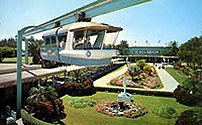

monorails & trainsIf you grew up as I did, on a steady diet of Popular Science magazine, you believed in the inevitability of the monorail. It seemed that every other issue had some mention of the train of the future, whether it used magnetic levitation, atomic propulsion or supersonic streamlining. Monorails were sleek, safe and mod. Worlds Fairs were not considered complete without a monorail to waft guests from exhibit to exhibit. And after all, weren't the Imagineers of Disneyland working to create a nationwide network of tracks, so we could be whisked from home to Tomorrowland in a few minutes? What happened? Nowadays, it seems that the mention of a monorail is a punch-line to some unstated joke about the na´ve futurism of the 1960s. I don't care. Nor, apparently do the members of the Monorail Society, an organization devoted to the preservation, advancement and enjoyment of the "train of tomorrow". Of course, monorails were built at more places than just the world's four Disneylands. Seattle has a good one in constant use by commuters, as do visitors to the Philadelphia and Miami Zoos. There are perhaps a dozen other monorails operating in the US. Brazil and Australia each have a couple, and continental Asia has a few. There are also a few in Europe and Britain, but for its size, Japan has by far the most monorails in the world, with ten in use, and another two being built. Probably the most ambitious monorail project in the works is presently being built in China by a German company. When completed in 2003, it will carry passengers in magnetically-levitated carriages at speeds of up to 500kph! Strangely, my favorite monorail is the least futuristic-looking of all. It is also the oldest surviving monorail in the world, dating from 1901! Three towns in the Ruhr district of Germany faced rapid expansion due to industrialization. The Wupper River that divided the towns was an impediment to bridges, so the decision was made to try this newfangled monorail thing. The design was certainly novel: former Victorian streetcars were suspended from an overhead rail, and swing freely as the track wends its way along, above the Wupper, held up by graceful, riveted steel trusses. The Kaiser himself was a guest at the opening celebration, and the era of the monorail had begun. Or so it was thought. The Wuppertal monorail has been a great success, carrying 70,000 people a day between 17 stations in comfort, quiet and style. Unfortunately, the cost of constructing monorail tracks is much greater than simply laying train tracks on the ground, hence the reluctance to invest in monorail development. Still, the monorail is still integral to anyone's view of the future. If nothing else, it reminds us of our capacity to dream of an ideal world. |








